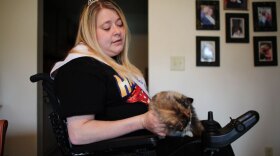Two years ago, Dorothy Holmes, then 75, was in the cozy pink bathroom of her home getting ready to shower when she fell. It's the type of accident that's common among older Americans — and it's often the very thing that triggers the end of independence.
"I got a big spot on my head; it almost conked me out," Holmes says in her soft voice.
She heard her husband come down the hall, "and when he turned the corner all I heard was, 'Oh God, honey, what did you do now?' After that I don't know anything 'cause I passed out," Holmes recalls.
Holmes spent almost three months in a hospital. Her heart stopped a few times, she had breathing and memory problems, and doctors removed an ulcer as big as a grapefruit.
These days, patients are often transferred from a hospital to a nursing home to recover. But some never leave.
"The only thing I worried about was not getting out," Holmes says now. She kept asking her husband and one daughter: "You're not going to keep me here are you?"
Holmes worried that her children and her husband wouldn't be able to handle her care at home in Belchertown, Mass.
"That was before Martha came into it and told us all we could get for help," Holmes says.
That's Martha Napierski, a case manager at WestMass ElderCare in Holyoke, Mass. She drew up a plan for Holmes' transition.
"We made sure she had home-delivered meals, personal care, homemaking seven days a week, sheets she needed for her bed and skilled nursing," Napierski explains. "She also had physical therapy and occupational therapy."
Napierski says Holmes would not have gone home without this help. It's help the federal government is packaging in a Medicaid program called Money Follows the Person. It identifies patients, old and young, who have been in a nursing home for at least 90 days but don't really need to be there. Massachusetts is one of 45 states in the program, created by the Deficit Reduction Act of 2005.
Holmes was a relatively easy patient to help make the transition because she had a place to return to and family who could help with her care. In many cases, Napierski has to start from scratch. Finding housing for patients who have given up their homes is the hardest part. Then Napierski shops for appliances, some basic furniture, and a few plates and cups.
"Even with that expense, it's definitely a savings to the state and federal government," says Priscilla Chalmers, Napierski's boss and director of WestMass ElderCare. That's compared with sometimes $9,000 a month for nursing home care, she says. "So it is a success from a humane point of view and also from the point of view of a cost savings to the state."
That may sound logical, but as of yet there is no proof of savings or happier patients. The program is off to a slow start.
Massachusetts had hoped to have more than 1,000 men and women enrolled by now. It has 306. Community agencies are still waiting for final rules for how they'll be paid — what's covered and which patients will qualify. The state has to establish connections in the program between housing, mental health, transportation and other departments.
And resettling patients who are used to life in a nursing home can be hard.
"It's a very complicated program for a variety of reasons," says Dr. Julian Harris, the Medicaid director in Massachusetts. "It's not a process that's sort of a one-size-fits-all."
Putting together all the things a patient may need — a guard dog, maybe, or the right home care, home renovations and rides to appointments — is challenging, Harris says.
But, she adds, "this administration has really made a commitment to making home- and community-based services possible."
The commitment goes back to a 1999 Supreme Court decision in Olmstead v. L.C. The judgement said that state Medicaid programs must pay for home care as long as it doesn't cost more than a nursing home or some other institution.
It will be several years before supporters of this program will be able to say whether it saves Medicaid money and participants are better off. But Dorothy Holmes is sure — she's really glad to be back home.
"It just means everything to me," Holmes says as a new puppy, Jack, jumps onto her lap. "My life is back, almost the way it always was."
Holmes is frustrated that a leg she injured in her fall is still not strong enough for walking any distance or climbing stairs. She's fine at home, but she wants to get out more, especially to visit a new great-granddaughter — her fourth great-grandchild.
This story is part of a reporting partnership that includes WBUR, NPR and Kaiser Health News.
Copyright 2013 WBUR




